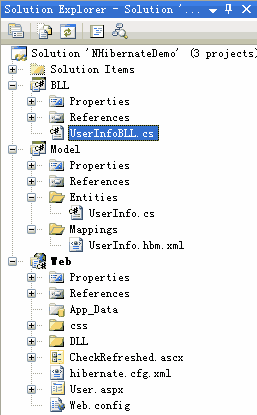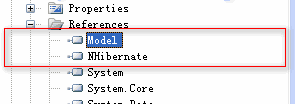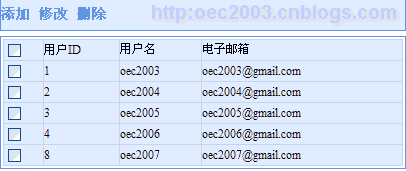NHibernate入门级示例(增 删 改) NHibernate相信大家都已非常熟悉,园子里有很多高手写了相关的系列文章,不过我还是NHibernate的一名初学者,在此将一个晚上学习成果分享一下,一个很简单的利用NHibernate实现增删改的例子。
本例中使用的NHibernate版本为版本为官方2008年9月29日最新发布的NHibernate-2.0.1.GA版本,点击下载
1 首先创建一个数据库NHibernateSample,使用的数据库版本为sqlserver2005。在该数据库中创建表UserInfo。
1 2 3 4 5 6 CREATE TABLE [dbo].[UserInfo] ( [UserInfoID] [int] IDENTITY(1,1) NOT NULL, [UserName] [varchar](20) COLLATE Chinese_PRC_CI_AS NULL, [Email] [varchar](100) COLLATE Chinese_PRC_CI_AS NULL )
2 打开vs2008,创建web application 命名为Web,解决方案的名称设为NHibernateDemo,然后在此解决方案下添加两个类库项目BLL和Model。
3 解压下载的NHibernate包,将NHibernate-2.0.1.GA-bin\bin\net-2.0目录下的dll文件复制到web项目中的DLL文件夹中。DLL文件夹用来存放一些公用的dll文件。
4 在Model项目中创建两个目录:Entities和Mappings。分别存放实体类和映射文件。
在Entities目录下创建类UserInfo.cs
1 2 3 4 5 6 public class UserInfo { public virtual int UserInfoID { get; set; } public virtual string UserName { get; set; } public virtual string Email { get; set; } }
需要注意到是实体类中的属性必须加virtual修饰符。
在Mappings目录下创建映射文件UserInfo.hbm.xml
1 2 3 4 5 6 7 8 9 10 11 12 <?xml version="1.0" encoding="utf-8" ?> <hibernate-mapping xmlns="urn:nhibernate-mapping-2.2" assembly="Model" namespace="Model"> <class name ="Model.Entities.UserInfo,Model" table="UserInfo"> <id name="UserInfoID" column="UserInfoID" type="Int32" unsaved-value="0"> <generator class ="native"></generator> </id> <property name="UserName" column ="UserName" type="string" length="20" not-null="false"/> <property name="Email" column="Email" type="string" length="100" not-null="false" ></property> </class> </hibernate-mapping>
映射文件创建好后,要修改该文件的输入操作为“嵌入式资源”,默认情况下为内容,在映射文件上右击属性,修改如下:
5 在BLL项目中创建类UserInfoBLL.cs 用来实现对UserInfo表的增删改操作。在BLL项目中添加对Model和NHibernate的引用
UserInfoBLL.csl类的代码如下:
1 2 3 4 5 6 7 8 9 10 11 12 13 14 15 16 17 18 19 20 21 22 23 24 25 26 27 28 29 30 31 32 33 34 35 36 37 38 39 40 41 42 43 44 45 46 47 48 49 50 51 52 53 54 55 56 57 58 59 60 61 62 63 64 65 66 67 68 69 70 71 72 73 74 75 76 77 78 79 80 81 82 83 84 85 86 87 88 89 90 91 92 public class UserInfoBLL { private string path = HttpContext.Current.Server.MapPath("~/hibernate.cfg.xml"); public bool Insert(UserInfo userInfo) { Configuration cfg = new Configuration().Configure(path); ISession session = cfg.BuildSessionFactory().OpenSession(); ITransaction transaction = session.BeginTransaction(); try { session.Save(userInfo); transaction.Commit(); return true; } catch (Exception e) { transaction.Rollback(); return false; } finally { session.Close(); } } public IList<UserInfo> GetUsers() { Configuration cfg = new Configuration().Configure(path); ISession session = cfg.BuildSessionFactory().OpenSession(); //使用HQL IList<UserInfo> list = session.CreateQuery(" from UserInfo") .List<UserInfo>(); return list; } public bool Update(UserInfo userInfo) { Configuration cfg = new Configuration().Configure(path); ISession session = cfg.BuildSessionFactory().OpenSession(); ITransaction transaction = session.BeginTransaction(); try { session.Update(userInfo); transaction.Commit(); return true; } catch (Exception e) { transaction.Rollback(); return false; } finally { session.Close(); } } public bool Delete(UserInfo userInfo) { Configuration cfg = new Configuration().Configure(path); ISession session = cfg.BuildSessionFactory().OpenSession(); ITransaction transaction = session.BeginTransaction(); try { session.Delete(userInfo); transaction.Commit(); return true; } catch (Exception e) { transaction.Rollback(); return false; } finally { session.Close(); } } public UserInfo GetUserInfoById(int userId) { Configuration cfg = new Configuration().Configure(path); ISession session = cfg.BuildSessionFactory().OpenSession(); return session.Get<UserInfo>(userId); } }
上面的GetUsers方法中用的是HQL查询的数据,NHibernate查询数据的方式有三种,具体参见NHibernate文档 。
6 在web项目的根目录下添加hibernate.cfg.xml文件,该文件用于配置一些数据库连接方面的信息。
1 2 3 4 5 6 7 8 9 10 11 12 13 14 15 16 17 <?xml version="1.0" encoding="utf-8"?> <hibernate-configuration xmlns="urn:nhibernate-configuration-2.2" > <session-factory name="NHibernateDemo"> <property name="connection.driver_class">NHibernate.Driver.SqlClientDriver</property> <property name="connection.connection_string"> Data Source=.\SQLEXPRESS;Initial Catalog=NHibernateSample; Integrated Security=True;Pooling=False;uid=sa;pwd=sa123 </property> <property name="adonet.batch_size">10</property> <property name="show_sql">false</property> <property name="dialect">NHibernate.Dialect.MsSql2005Dialect</property> <property name="use_outer_join">true</property> <property name="command_timeout">10</property> <property name="query.substitutions">true 1, false 0, yes 'Y', no 'N'</property> <mapping assembly="Model"/> </session-factory> </hibernate-configuration>
7 在web项目中添加Model和BLL的引用。
接着添加页面User.aspx,前台的现实我们使用repeater控件
1 2 3 4 5 6 7 8 9 10 11 12 13 14 15 16 17 18 19 20 21 22 23 24 25 26 27 28 29 30 31 32 33 34 35 36 37 38 39 40 41 <asp:Repeater ID="rptUserInfo" runat="server"> <HeaderTemplate> <table id="tblUserInfo" border="0" width="100%" cellpadding="0" cellspacing="1"> <tr> <td> <input type="checkbox" id="chkAll" name="chkAll" value="checkbox" onclick="checkAll('chkAll',this);" /> </td> <td> 用户ID </td> <td> 用户名 </td> <td> 电子邮箱 </td> </tr> </HeaderTemplate> <ItemTemplate> <tr> <td> <input type="checkbox" name="chkSelect" value='<%# (Container.DataItem as Model.Entities.UserInfo).UserInfoID %>' onclick="checkAll('chkAll',this);" /> </td> <td> <%# (Container.DataItem as Model.Entities.UserInfo).UserInfoID%> </td> <td> <%# (Container.DataItem as Model.Entities.UserInfo).UserName%> </td> <td> <%# (Container.DataItem as Model.Entities.UserInfo).Email%> </td> </tr> </ItemTemplate> <FooterTemplate> </table> </FooterTemplate> </asp:Repeater>
后台绑定方法
1 2 3 4 5 6 7 private void BindInfo() { UserInfoBLL u = new UserInfoBLL(); IList<Model.Entities.UserInfo> list = u.GetUsers(); rptUserInfo.DataSource = list; rptUserInfo.DataBind(); }
新增,修改和删除的代码就不一一贴出了,因为比较简单 就是调用UserInfoBLL类中的方法而已,大家可以在下面下载本实例的源码看。
最后的运行结果
需要注意的地方:
实体类中的属性要加virtual修饰符。
实体类的映射文件UserInfo.hbm.xml 的生成操作默认为为“Content(内容)”,要将之改为“Embedded Resource(嵌入式资源)”
hibernate.cfg.xml配置文件的connection.connection_string 要修改为自己的连接串。
终于写完,由于刚接触NHibernate,不好的地方希望大家批评指正,希望对初学NHibernate的朋友有所帮助。
NHibernateDemo示例下载







